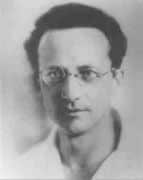Is the struggle between the greats of quantum physics, Bohr and Schrödinger, finally coming to a solution? Researchers from Yale University recently published in the famous journal Nature an article indicating that a quantum jump is actually continuous as Schrödinger claimed and not momentary as Bohr thought

Atomic systems in nature hide discrete phenomena originating from quantum theory. A famous example of this comes from the spectrum of light emitted from hot bodies. Excited atoms, or in other words atoms that have absorbed energy, emit randomly and in short times the energy they absorbed back into the environment. That energy is emitted in discrete doses corresponding to the discrete energy levels of each atom. For years physicists around the world have tried to answer the question of whether it is possible to predict when an atom will emit the energy back? Is it possible to identify preliminary signs that will testify towards her release? At the beginning of the 20th century, physicists were divided into two camps - those who sided with Bohr on the claim that the energy transition occurs instantaneously, hence the name "quantum jump" (between different levels of energy),

Or with the concept of Schrödinger, who claimed that it is a continuous and coherent transition. Over the years, support for Schrödinger's concept grew and received theoretical reinforcement through the "quantum track theory". The mathematical problem is similar to the classical problem of tsunami predictions. On the one hand, it is difficult to predict
Over time when the next tsunami will hit the coast, but there are early signs that may indicate if and when the tsunami will occur. Alongside mathematical developments, very few experiments were conducted to measure a quantum jump in the laboratory. The first time a quantum transition between energy levels in an atom was observed in the laboratory was in 1986, but unfortunately the measurement systems were not sensitive enough to answer the question of whether it was a momentary jump or a continuous transition.
Now that sensitive technologies are at our disposal, researchers at Yale University decided to try to answer these fundamental questions. Using a superconductor they assembled a system that simulates an atom with three different energy levels. Under this experimental system, the researchers were able to show a continuous and coherent transition between energy levels and strengthen the quantum track theory. In addition, under electrical pulses the researchers were able to stop the process before it was completed and return the dummy atom to the excited state.
mock atom
For the curious reader, the following is the measurement method in general terms: the simulated atom contains three energy levels. These levels were called G [from the English word ground (basic level)], D [from the English word darkness], and level B [from the English word bright as well]. The bright level is so called due to the fact that when the transition from it to the ground state will emit a photon (particle of light) that can be measured. A dark state is referred to as such because it cannot be detected directly by the emission of light. When the system lights up, the researchers know that there is a transition between B and G. The uniqueness of this experiment comes from the fact that the experimenters can now measure individual photons (indirectly) that are emitted from the dummy atom. During the transition, the system "informs", so to speak, of a transition by dimming the lighting intensity. As soon as no photons were observed, the system completed the transition to the dark state.

According to the Mail researchers, "Quantum jumps do appear to be random and discrete over time, but the fact that such a jump can be fixed means that its temporal development is characterized, in some way, by deterministic laws. The jump always happens in the same way, in the same pattern." The researchers add that "the experimental result will serve as a basis for technological methods that can control quantum systems and correct errors in quantum computers on the fly." Unintended quantum jumps can indicate calculation errors. If researchers can detect such jumps while alive
Again, you will open another way to build multi-qubit quantum computers.
For the scientific article in Nature:

11 תגובות
Damn Schrödinger and damn his memory forever.
It's a shame that there is no word on what a "simulated atom" is and why do you think you can infer from it a real atom
To the response of "just screwed" the article is definitely serious, conductivity on it is a completely real thing and the conductive cable on the first one was created back in 1962, you can search for it on Google if you want to learn more about it
Listen to Dr. Kobi Arad explain the phenomenon and its implications
https://youtu.be/YOpMCMCaGOc
Regarding the question for the physicist - even if I lower the requirement for excitation and not ionization (that is, don't tear the electron, just increase its energy), the answer is no. The energy states that an electron can find under the attraction to the atomic nucleus are still discrete and only the appropriate energy can bounce an electron from one state to another. The electron can be said to still jump, meaning it is not in a stable state between energy states. The difference is that the transition does not occur momentarily, but at a finite and fixed time. Because there is a clear pattern to the transition, researchers can stop the jump while it is happening. I hope this answers Ami's question. The electron can indeed stay in discrete energy states only, while the jump is not momentary, but continuous in time. Regarding cancer, I am not the authority to answer, but I can say that strong energy is still required to cause cancer (X-ray, gamma, beta with sufficient energy, etc.), not all radiation harms humans.
If we say that the experiment is correct..
Is it possible to conclude from this that any type of radiation can cause ionization with a certain probability and cancer..
regardless of its power?
Is it about the levels where the electron is around the nucleus? And therefore, wouldn't it be more correct to say that an electron can only be "observed" at certain energy levels, but not continuously between them (and I hope I asked in an understandable way...)?
Not a serious article
His son "superconducts"
Probably only in theory (or is it Iron Man)
The phrase "the system that simulates an atom" is meant to indicate that the system contains discrete energy levels that can be measured and evaluated. Just like an atom that has discrete energy levels that it can find in. Moreover, the electrons, in an atom and a conductor, are the elementary bodies that jump between energy levels.
"Put together a system that simulates an atom"
Is this serious?
The very fact that they manage to do these experiments is more surprising than the results of the experiment itself.